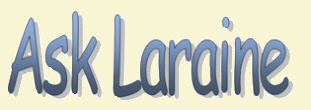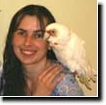Fungal Infections
Gouldians & Other Finch Species
Kristen Reeves, Meadowlark Farms Avian Supply, Inc.
I have seen very few fungal infections in my aviary, but have included the information here so that you have an understanding of them and what the signs may be of infection.
ASPERGILLIOSIS
This is a mold commonly seen on decaying food like bread or cheese and is caused by the fungus aflatoxin. In the aviary, it may be found in seed that has been in an unsealed container that has absorbed moisture, on soft or wet foods that have sat too long, or in bedding used in cage trays or aviary floors. It is spread through spores and infects the bird when inhaled or ingested causing pneumonia-like symptoms. This fungus can produce poisonous toxins that can damage internal organs, much the way some of the bacterial infections do.
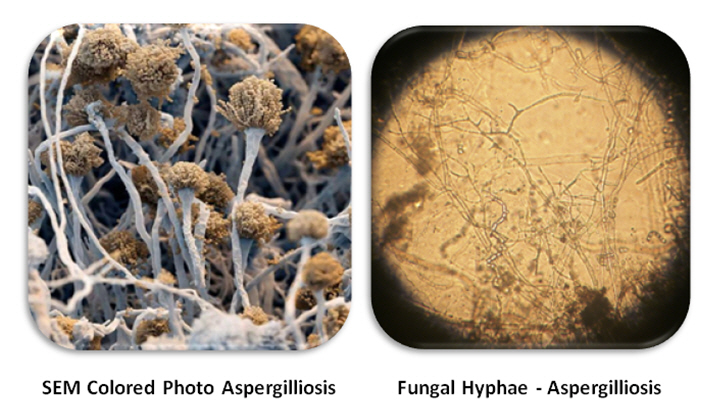
Seed that has gotten wet and has become moldy, warm, humid conditions, and poor hygiene can all contribute to this establishment of this disease. Once the fungus takes hold, it multiplies by branching out and creating “mats” in the airways including the nostrils, sinuses, eyes, and other cavities of the head, as well as the lungs. Symptoms include respiratory distress with the bird wheezing and gasping - generally, labored breathing and tail bobbing, but may also include neurological symptoms such as twirling and stargazing. Clicking sounds may be heard. In severe infections, the eyelids may become filled with cheesy, yellow masses - as they are so close to the sinus cavities.
This disease is virtually impossible to diagnose while the bird is alive, and is only determined upon necropsy of the infected bird. However, you can test seed for aflatoxin by shining a Wood’s Lamp (specialized black light) on the seed. If the fungus is present, the seed will fluoresce green.
The only known medication to have any effect is Amphotericin, however, it does not always work and may not work at all - it is also very expensive. Therefore, prevention is the best course of action. Keeping aviaries dry, clean, and free from dust and mold is the only way to prevent this problem. If this fungus does become a problem, the entire aviary must be thoroughly cleaned with a bleach or Virkon S solution to kill the mold spores. Items with the potential for growing the mold must be disposed of.
CANDIDA (Yeast or Thrush)
“Candida are colonies of single, oval cells which bud and in some circumstances develop into chains or hyphae. They most frequently attack the epithelium of the crop. The infection can be induced by prolonged use of antibiotics, such as the tetracyclines, in the drinking water… “ Arnall and Keymer, 1975
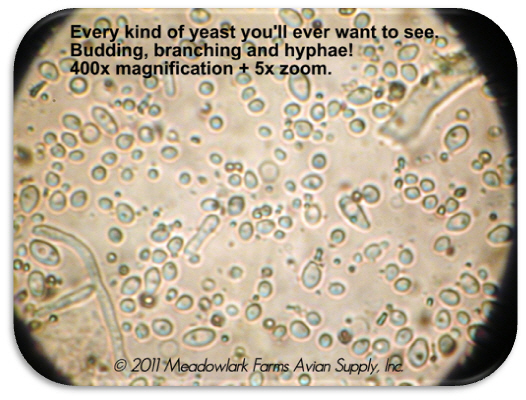
Candida, otherwise known as a yeast infection or thrush, is usually caused by prolonged use of antibiotics, but may also be caused by poor hygiene, overcrowding and poor animal husbandry management. Antibiotics kill good and bad bacteria, and leave the immune system weak and unable to fend off other problems - in this case, Candida. In my aviary, I often give the birds (other than Gouldians – see Dr. Rob Marshall’s Sterile Bowel Theory) probiotics after treating with antibiotics to help them regain a normal gut flora and rebuild the good bacteria in their systems.
Signs of Candida may include regurgitation of food, loose dark green and tacky droppings, a fluffy and messy look to the bird, and a “sleepy” look in the eyes. The bird may have patches of white, raised dead epithelial material in the mouth and crop. This will look “cheesy” and is easily scraped off. On occasion, these lesions may hinder breathing, causing the tail bob we commonly see with respiratory distress.
Preventing Candida is easily achieved with proper hygiene, nutrition and the use of Probiotics after prolonged antibiotic use. It is thought that a vitamin B complex (specifically - formic acid) deficiency may open up the bird to the disease.
Most times, Nystatin (Medistatin for birds) is the medication of choice when the infection cannot be controlled with probiotics. Copper Sulfate is sometimes given in the water. Dimetridazole or Ronidazole have sometimes been effective because it prevents a common secondary infection caused by Trichomonads (most common protozoa in aviary birds).
AVIAN GASTRIC YEAST (AGY)
Also known as Megabacteria, AGY is difficult to cure and the only medication known to be remotely effective - Amphotericin B - is very expensive. It is NOT highly contagious as long as the overall health of the flock is good, though it is advisable to add an acid based water cleanser like MegaMix to the water (begin with 1/4 tsp up to 1 tsp to 1 liter of water) for the rest of the flock. It is easily diagnosable through fecal smears and viewing under the microscope. Even at 100x, this mostly rod-shaped pseudo-bacteria is easily spotted and looks like fine hairs.
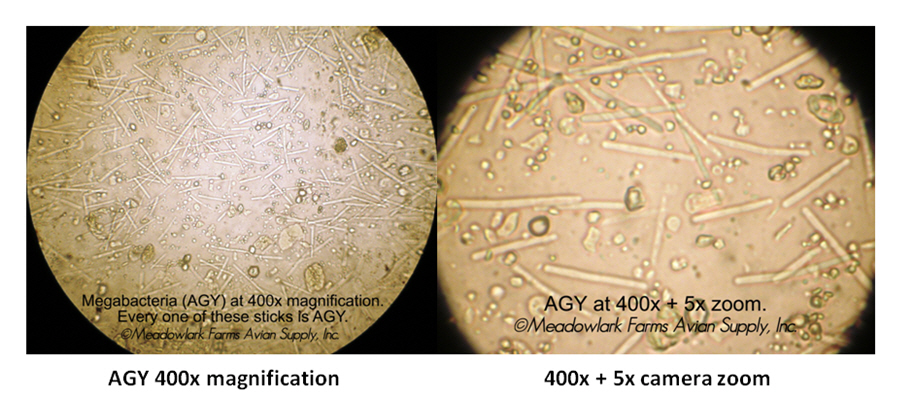
Word of caution - if you use diatomaceous earth on your bird’s food or in the cage/nest boxes, be sure to check several fecal smears before panicking. D-earth contains small particles in many shapes and forms. It is not digested and absorbed, so it is passed in the droppings whole. Many of the shapes d-earth contains look very much like AGY, Coccidia, worm eggs, etc. Be sure to view all foods and supplements under the microscope so you have an idea of what you are looking at before you panic!
Symptoms of AGY include vomiting, going light, general weakness and depression, failure to thrive, fluffing, increased appetite with no weight gain, trembling, hunched over, and/or metabolic disturbances. In very ill birds, neurological problems or those affecting the central nervous system like twirling and star gazing may be present. Hens may become egg bound or become paralyzed after laying their eggs.
RINGWORM
While the name implies that this infection is a parasite, it is actually a fungal infection of the skin. It is only included here for reference as the probability of it entering your aviary is highly unlikely.
The ringworm fungus causes lesions that appear scaly and dusty, not unlike scaly face/leg mites. It primarily affects the skin of the head, but may affect any thin-skinned area on the bird. It spreads slowly from bird to bird and can usually be stopped in it's tracks without spreading if diagnosed early.
Treatment may be in the form of antifungal creams. After diagnosing this issue, your Veterinarian may prescribe Griseofulvin, which is used for all types of dermatomycosis (fungal infection of the skin). If the infection has spread to other birds and cannot be controlled, your Veterinarian may recommend euthanasia.
BEAK, SCALE & OTHER FUNGUS
On rare occasion, we may find we have a bird with a beak or leg scale fungus. This can only be diagnosed through scrapings, and then viewed under the microscope at high magnification. These fungal infections are not unlike those found in humans affecting the finger and toenails, or with athlete’s foot. Well established fungal infections are difficult to eradicate, but with an over the counter fungal cream (Terbinafine Hydrochloride, Butenafine Hydrochloride or Clotrimazole), can usually be controlled and eventually cured.
It is important to be consistent in the application of any cream or salve you use. It should never be applied directly to feathers, and should not get in the nares (nostrils), or in the birds beak. Your Veterinarian may give you a prescription fungal medication that may be more effective than an over the counter type.
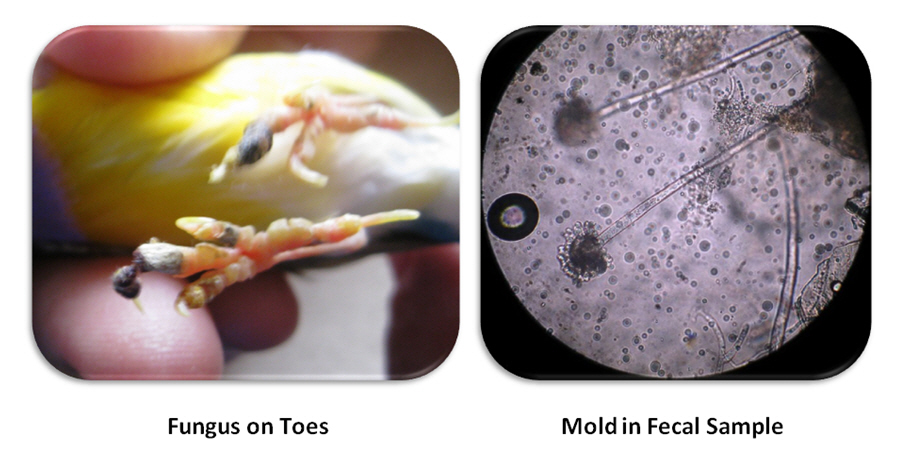
A client from Brazil sent these photos of her Gouldian finch giving credence to the need for dry perches. Due to a foot fungus caused by consistently high heat and humidity situations, this bird lost several of his toes, but once the fungus was treated and eradicated, he went on to live a healthy and fruitful life.
FINAL WORD...
The information contained here is for reference purposes only. As always, if you suspect your bird is sick, take it to an Avian Veterinarian!

